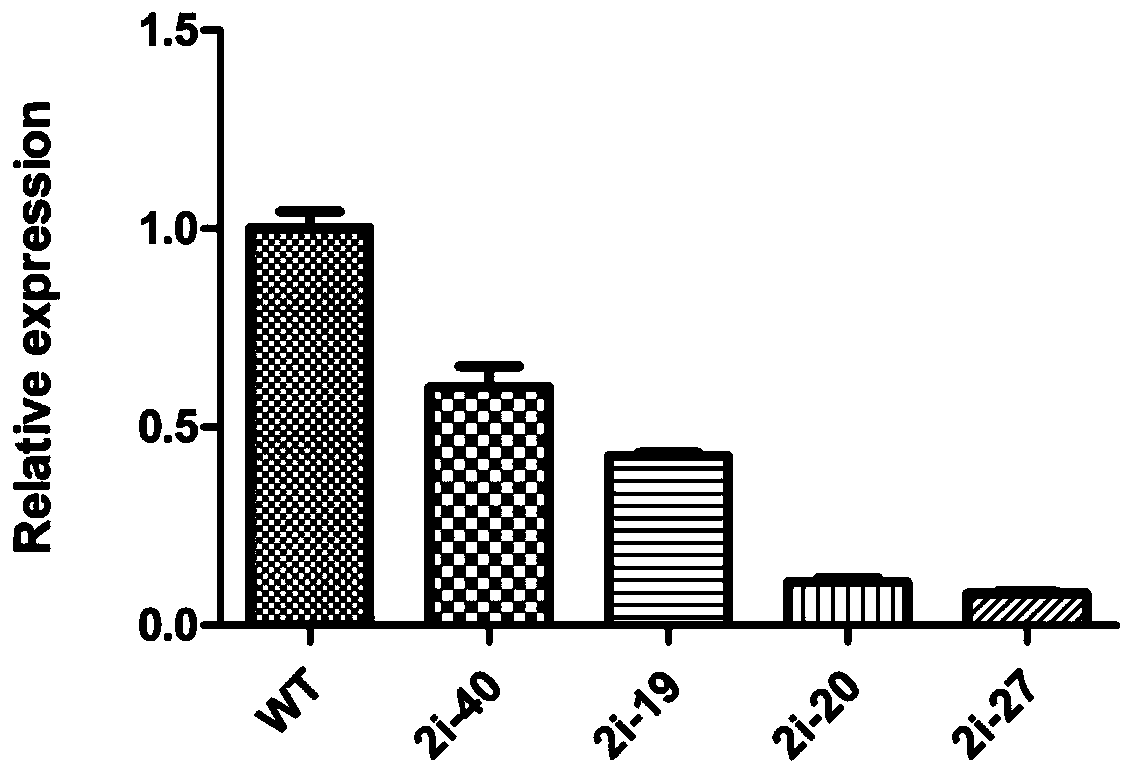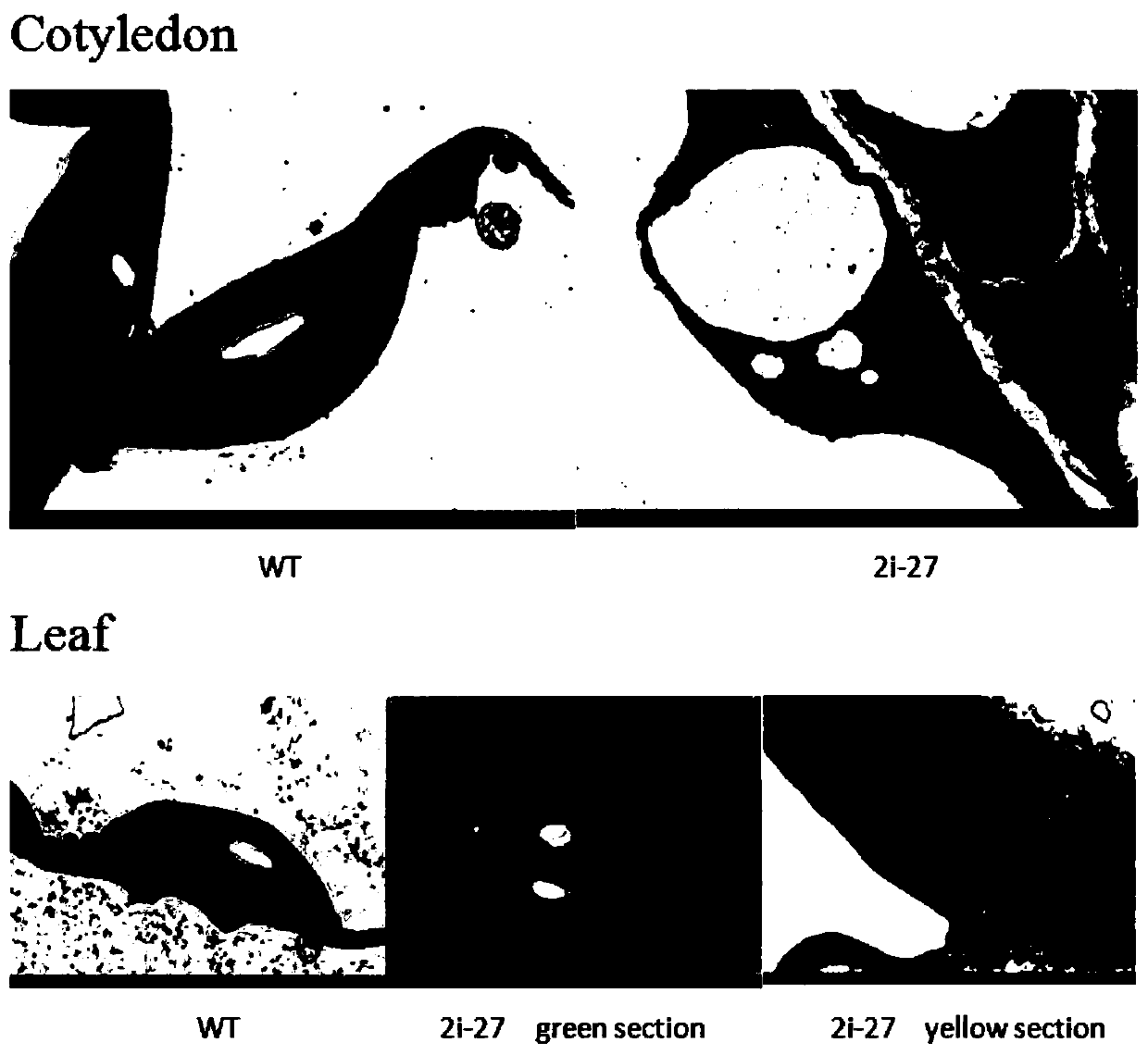Application of gene CDA1 in regulation and control of chloroplast development
A chloroplast and gene technology, applied in the field of plant genetic engineering and cell biology, can solve the problem of unclear regulatory molecular mechanism
- Summary
- Abstract
- Description
- Claims
- Application Information
AI Technical Summary
Problems solved by technology
Method used
Image
Examples
Embodiment 1
[0049] Example 1: Construction of CDA1 gene interference strains, CDA1 gene mutants and tag vectors
[0050] 1. Construction of CDA1 gene interference strain:
[0051] 1.1 Construction of interference carrier:
[0052] The backbone interference vector pCAMBIA2300RNAi-CDA1 was obtained by transforming pCAMBIA2300. Primers (CDA1IF and CDA1IR) were designed according to the CDS sequence of the CDA1 gene to amplify a 256bp specific fragment (SEQ ID NO.5) on the CDA1 gene. After the fragment was recovered by agarose gel electrophoresis, primers CDA1-PstL and CDA1-KpnR were designed to amplify the specific fragment, and then the PCR fragment and the pCAMBIA2300RNAi-CDA1 vector were digested with KpnI and PstI. pCAMBIA2300RNAi-CDA1 of the chain exogenous fragment. Take 1 μL of the ligation product and transform it into Escherichia coli DH5α by the freeze-thaw method, and coat the transformed product with kanamycin-resistant (50 μg / mL) LB medium. Cultivate overnight at 37°C, and p...
Embodiment 2
[0089] Embodiment 2: Electron microscope observation of chloroplast
[0090] Fresh leaves from the same part of the intervention line (2i-27) and wild type (WT) were selected at the seedling and bolting stages. The sample was fixed with 2.5% glutaraldehyde (25% glutaraldehyde was diluted to 2.5% with pH 7.2, 0.2M phosphate buffer), vacuumed until the leaves all sank to the bottom of the tube, and kept overnight at 4°C. After washing three times with 0.2M phosphate buffer (pH 7.2), fix with 1% osmic acid fixative (pH 7.0) for 2h. After the fixation was completed, the cells were washed again with phosphate buffer for 3 times, each time for 10 min. Enter the dehydration link afterwards, alcohol gradient dehydration at all levels, each 30min, alcohol gradient is successively 30%, 50%, 70%, 80%, 90%, 100% ethanol (twice). When dehydration is complete, discard the alcohol. The material is infiltrated sequentially with the mixture of alcohol and SPI-812 resin according to the grad...
Embodiment 3
[0092] Example 3: Subcellular Localization Experiment
[0093] The principle of the subcellular localization experiment is to transfer the high-purity, transfection-grade target gene-GFP fusion expression plasmid into the isolated Arabidopsis thaliana mesophyll cell protoplasts, and use PEG-Ca 2+ In the mediated method, after the fusion protein is expressed in protoplasts, the localization of the target gene can be determined by observing the localization of the green fluorescence in the cell with a Leica confocal microscope. Extraction of subcellular localization vector plasmids QIAGEN Plasmid Midi Kit (http: / / www.qiagen.com / ) was used to prepare transfection-grade plasmids. Isolation of protoplasts was performed according to the method reported by Yoo et al. (2007). with PEG-Ca 2+ Mediated method After the expression vector was transformed into Arabidopsis protoplasts, cultured overnight at room temperature in the dark. Since the target gene in this study is predicted to ...
PUM
 Login to View More
Login to View More Abstract
Description
Claims
Application Information
 Login to View More
Login to View More - R&D
- Intellectual Property
- Life Sciences
- Materials
- Tech Scout
- Unparalleled Data Quality
- Higher Quality Content
- 60% Fewer Hallucinations
Browse by: Latest US Patents, China's latest patents, Technical Efficacy Thesaurus, Application Domain, Technology Topic, Popular Technical Reports.
© 2025 PatSnap. All rights reserved.Legal|Privacy policy|Modern Slavery Act Transparency Statement|Sitemap|About US| Contact US: help@patsnap.com



